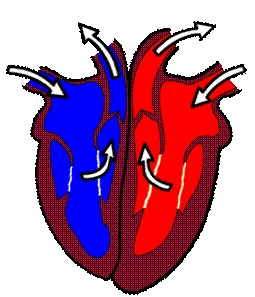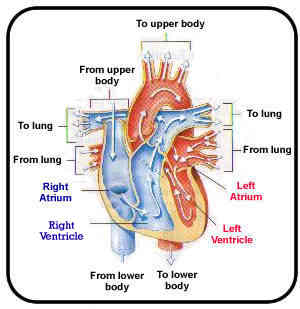
| Home | CIRCULATORY SYSTEM- MECHANISM OF BLOOD CIRCULATION |
The mechanism of blood circulation takes place in two phase/stages, namely:
Systemic circulation
Pulmonary circulation
Systemic circulation
The systemic circulation is the movement of blood from the heart to the other parts of the body other than the lungs. This phase starts from the left ventricleand terminates at the right auricle. During this phase, the blood passes from the left ventriclevia the aorticvalveto the aorta. From the aorta the blood is distributed to various arteries, arterioles and then the capillaries. Within the capillaries, the nutrient contents of the blood and oxygen are released into the surrounding cells of the body. At the same time carbon dioxide and other waste products are absorbed into the capillaries from the body cells. The absorbed carbon dioxide and waste products then enters the circulation. From the capillaries originates the venules and then veins. The absorbed carbon dioxide and waste products then enters the venules, veins and are transported to the lungs/kidney via the superior and inferior vena cava, where they are expelled from the body.
Pulmonary Circulation
The pulmonary circulation is the phase of the blood circulatory system whereby the deoxygenated blood is transported between the lungs and the heart. This stage starts from the right ventricleand terminates in the left auricle. Deoxygenated blood from all parts of the body is transported to the right ventricle, the pulmonary semilunar valve to the pulmonary arteryand then the lungs. Within the lungs the deoxygenated blood is enriched with oxygen and becomes oxygenated. At the same time carbon dioxide is released into the lungs and later on released into the atmosphere during exhalation. While the oxygenated blood is transported to all parts of the blood where it can be used to fuel all metabolic processes such respiration, walking, thinking, reproduction, excretion etc.
Coronary circulation.
The coronary circulation takes place within the heart. This system starts from the ascending aorta and it consists of right and left coronary arteries. Blood is normally collected from the major, minor and middle coronary veins and terminates in the right auricle. Below is the picture of the blood vessels of the coronary circulation |
|
Below is diagram illustration the blood circulatory system- Systemic and pulmonary.

.
.
.
.
.
.
.
Figure Image of the blood circulatory system- Systemic and pulmonary
How the blood flows round the body?
Deoxygenated blood from all parts of the body that contains carbon dioxide and other metabolic products poured into the superior vena cava and inferior vena cava. The superior vena cava and inferior vena cava sends the deoxygenated blood and waste product into right auricle of the heart. The right auricle then pours the blood via the tricuspid valve into the right auricle of the heart. The right ventricle then pumps the blood into the pulmonary arteryvia the pulmonary semilunar valve.
However, oxygenated blood from the lungs is transported to the heart via the pulmonary veins, then into the left auricle. The blood then passes from the left auricle via the mitral valve into the left ventricle. From the left ventricle, the blood is pumped from the heart into the aorta via the aortic semilunar valve. The aorta then distributes the blood via various arteries to all parts of the body.


Figure movement of the blood through the heart
| PREV | NEXT |
